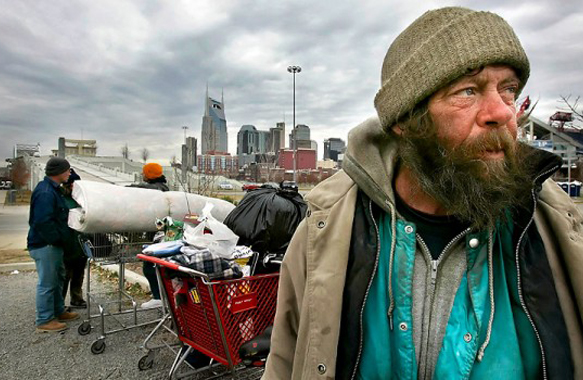It is 4:30 AM. The morning frost has not yet begun to melt. She shivers. It is freezing cold outside; twenty-nine degrees in the sun were it out. In her home the temperature is not much better. Sandra cannot afford to turn on the heat. She scurries about hoping she will warm up, but that matters not. There are more important things in life. Her job, the income it provides so that she might buy food for herself and her children. There is nothing for breakfast. Sandra asks herself, will she make it to lunch? Will her children? Thank goodness for school and the Breakfast Program. Her mind wanders. Her body moves blindly through the motions. As she readies for the day she turns on the TV. Once again she hears the refrain; “You have a TV, a job, and a roof over your head. What more do you want? You should be grateful; you are privileged. You live in the best country in the world. You are an American and America is exceptional! So stop making excuses.”
Sandra does not respond. Indeed she barely notices the words that define her life, or those who utter these. She is numb, not dumb, just poor and impoverished…some say that she is void of an education. Blithely, those with millions and billions say, “She is ignorant.” But how could that be? She has a degree, High School and College. What is missing from her life? A living wage, adequate health care coverage, and opportunities, these are as she, invisible and indicted. Made wrong. What is right? If only someone cared or listened; instead people talk.
Education expert, Michelle Rhee exclaims, Poverty Must be Tackled But Never Used as an Excuse. “High Quality Education Is the Best Tool to Fight Poverty.” Social programs being the route out of poverty, that premise, Michelle Rhee says, is wrong. But pray tell Ms Rhee; what does afford social-mobility? Please tell us. Eighty percent of the total American population wants to know.
“No excuses”? “There are takers and makers,” and which is Sandra? She makes money, but not enough to live on. She takes…great care, but receives very little. What does that make her? Where does that leave her, you, or me?
In the U.S. 49.7 Million Are Now Poor, and 80% of the Total Population Is Near Poverty
If you live in the United States, there is a good chance that you are now living in poverty or near poverty. Nearly 50 million Americans, (49.7 Million), are living below the poverty line, with 80% of the entire U.S. population living near poverty or below it.
That near poverty statistic is perhaps more startling than the 50 million Americans below the poverty line, because it translates to a full 80% of the population struggling with joblessness, near-poverty or reliance on government assistance to help make ends meet.
In September, the Associated Press pointed to survey data that told of an increasingly widening gap between rich and poor, as well as the loss of good-paying manufacturing jobs that used to provide opportunities for the “Working Class” to explain an increasing trend towards poverty in the U.S.
But the numbers of those below the poverty line does not merely reflect the number of jobless Americans. Instead, according to a revised census measure released Wednesday, the number – 3 million higher than what the official government numbers imagine – are also due to out-of-pocket medical costs and work-related expenses.
The new measure is generally “considered more reliable by social scientists because it factors in living expenses as well as the effects of government aid, such as food stamps and tax credits,” according to Hope Yen reporting for the Associated Press.
Some other findings revealed that food stamps helped 5 million people barely reach above the poverty line. That means that the actual poverty rate is even higher, as without such aid, poverty rate would rise from 16 percent to 17.6 percent.
Latino and Asian Americans saw an increase in poverty, rising to 27.8 percent and 16.7 percent respectively, from 25.8 percent and 11.8 percent under official government numbers. African-Americans, however, saw a very small decrease, from 27.3 percent to 25.8 percent which the study documents is due to government assistance programs. Non-Hispanic whites too rose from 9.8 percent to 10.7 percent in poverty.
“The primary reason that poverty remains so high,” Sheldon Danziger, a University of Michigan economist said, “is that the benefits of a growing economy are no longer being shared by all workers as they were in the quarter-century following the end of World War II.”
“Given current economic conditions,” he continued, “poverty will not be substantially reduced unless government does more to help the working poor.”
Meanwhile, the U.S. government seems to think that the answer is cutting more of those services which are helping to keep 80% of the population just barely above the poverty line, cutting Food Stamps since the beginning of the month. Democrats and Republicans are negotiating about just how much more of these programs should be cut, but neither party is arguing that they should not be touched.
(Article by Simeon Ari; photo via AP Photo | Introductory Essay by Betsy L. Angert | © copyright 2013 Betsy L. Angert)












Great article. Keep up the good work.